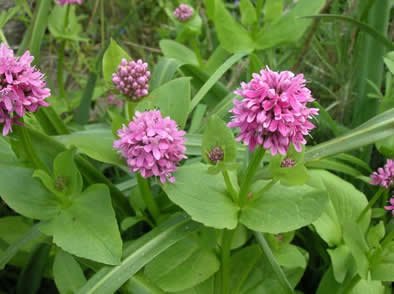|
NATURE NOTES |

Sea blush (Plectritis congesta), photo by Adolf Ceska.
Wildflower Genetics: Fruit Polymorphisms in Sea Blush
(Plectritis congesta and Plectritis brachystemon)
by
Anthony J. F. Griffiths and Fred R. Ganders
Plants of the genus Plectritis exhibit an incredible amount of variation in their small dry, seed-like fruits. Some of the fruit types are so distinctive that many individual species were named according to these differences, until it was recognized that they merely represented genetic polymorphisms within populations. The fruits exhibit a variety of shapes, involving the presence or absence of two earlike wings, the shape and curvature of the wings, the presence and location of hairs on the fruits, and the colour, which ranges from pale straw colour through yellowish and golden brown to dark brown. Length also varies from two to four millimeters.
These characters are inherited--as can be seen in selfed offspring that are grown in the same environment for several generations--but the actual genetics of most of the characters has not yet been worked out. In British Columbia, both P. congesta and P. brachystemon show these fruit variations. Although many different morphs are typically found in populations of P. congesta, populations of P. brachystemon are usually relatively uniform and often consist of plants that have all identical fruits. The reason for this is that P. congesta routinely cross-pollinates and P. brachystemon is highly self-pollinated, and genetic variation is more easily lost from highly self-pollinated populations, either by selection or by random events.
Although the genetics of wing shape is not known, the polymorphism for the presence or absence of wings has been studied quite thoroughly. It is controlled by a single gene, with the allele for wings dominant to the allele for the absence of wings. The mode of inheritance is the same in both P. congesta and P. brachystemon. A single dominant gene for winged fruits also occurs in some species in the closely related genus Valerianella in the southeastern United States, suggesting that this polymorphism may be older than the evolutionary divergence of the two genera.
The frequencies of winged and wingless fruited plants vary dramatically in different populations of sea blush. In P. congesta we have found populations with phenotype frequencies ranging from only 29 percent winged to 100 percent winged, but nearly all have both forms present. There is no apparent geographical pattern to the distribution of frequencies. This does not, however, eliminate the possibility that more subtle characteristics of the individual habitats might be correlated with frequency of winged plants.
In P. brachystemon, most populations are either completely winged or completely wingless. Populations on southeastern Vancouver Island are constant for the wingless fruited allele. We have seen polymorphic populations on Sumas Mountain and the Sechelt Peninsula, but even in these populations the two forms are not randomly distributed. Rather, one finds distinct patches where one fruit form of the other predominates. This could be caused by microhabitat differences within the population favouring one form or the other, but this hypothesis has not been tested. Since P. brachystemon normally self-pollinates, however, nearly all of the plants are homozygous, and the offspring will be like their parent. Since most seeds are distributed near the parent plant, clumps of plants of the same form are bound to become established.
The fruit-wing polymorphism in P. congesta is one of the few cases where there is evidence that the polymorphism is maintained by heterozygote advantage. (Wingless fruited plants are homozygous for the recessive wingless allele, with genotype ww, while winged fruited plants can be either homozygous dominant WW or heterozygous Ww.). Genetic studies of natural populations have shown that there are more heterozygotes than expected according to the laws of population genetics. In addition, studies of the three genotypes grown under uniform experimental conditions have confirmed that heterozygotes are larger and have more inflorescences. Since heterozygotes have both alleles in their genotypes, if they have a selective advantage both alleles will be maintained in the population. Also, since both homozygous and heterozygous winged plants have identical fruit wings, the heterozygote advantage is not directly related to the wings. Either the winged and wingless alleles have other effects on the development or physiology of the plants, or the advantageous effects of heterozygosity are not caused by the fruit-wing locus itself but are caused by other genes that are tightly linked with it.
The demonstrated heterozygote advantage is sufficient to maintain polymorphic populations in P. congesta, and the high percentage of polymorphic populations that exists is consistent with this explanation. Plectritis brachystemon, however, so frequently self-pollinates that virtually all of the plants in natural populations are homozygous. Thus, there are no heterozygotes to have an advantage. Where cross-pollination is so rare that heterozygotes are seldom produced, their advantage is not great enough to prevent one allele from being lost from the population either by selection or random genetic events.
Reprinted from Anthony J. F. Griffiths and Fred R. Ganders. 1983. Wildflowers Genetics: A Field Guide for British Columbia and the Pacific Northwest.
Flight Press, Vancouver--with permission.
This publication is available for purchase from the UBC Botanical Garden gift shop.
Recommended citation: Author, date, page title. In: Klinkenberg, Brian. (Editor) 2021. E-Flora BC: Electronic Atlas of the Flora of British Columbia [eflora.bc.ca]. Lab for Advanced Spatial Analysis, Department of Geography, University of British Columbia, Vancouver. [Date Accessed]
E-Flora BC: An initiative of the Spatial Data Lab, Department of Geography UBC, and the UBC Herbarium.
© Copyright 2021 E-Flora BC.